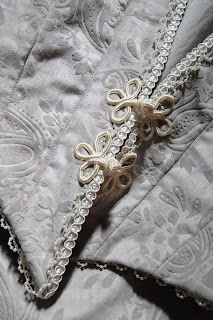Victorian Hairwork; Mourning or not?
Mourning pendant done in sepia work where hair is pulverized and mixed with the paint used for the picture, and at times, accented with hair, (Charleston Museum)
Hair cross, possibly mourning due to seed pearl (represents tears) and black enamel trim on gold,(Charleston Museum)
Hair brooch, probably a sentimental piece, (Charleston Museum)
Hair bouquet in shadow box frame, art form with hair samples from family/friends accented with beads for décor purposes,
(private collection)
Hair bracelets, possibly mourning (if inscribed on the clasp), otherwise fashion jewelry or love tokens, (Charleston Museum)
For those who enjoy hairwork of the 19th century it can be confusing as to whether or not it represents mourning or sentimentality.
Surprisingly, when searching for these items they are generally listed as mourning when in fact most examples are love tokens.
During the mourning period of the Victorian era, strict guidelines were adhered to regarding length of mourning, behavior, and attire. Mourning customs varied depending upon region, socioeconomic status, who was mourning, and for whom they were grieving.
Generally, mourning was broken down into two segments; first or full mourning and second or half mourning (in some cases second mourning was divided into two increments).
A woman in first mourning was only permitted to wear jewelry made of Jet or Jet-like substances (the topic of Jet is another discussion:). Hair jewelry was not generally worn until second mourning (please keep in mind that this rule may differ depending on the source).
Certain aspects should be considered when trying to determine if a hairwork piece is mourning or a love token. The only way to prove unequivocally that a piece is for mourning is if it has one or more of the following aspects:
the phrase 'In Memory of,'
IMO (initials for aforementioned phrase),
mourning symbolism such as an urn, headstone, or sometimes a cross,
black enamel trim/accents or Jet/Jet-like casing
date of death inscribed on the piece
Without the above characteristics one must study the piece to identify its original purpose. In some cases one can only speculate as to the original intent.
For example, there are some mourning brooches with woven hair compartments framed with precious stones not normally affiliated with death (garnets and seed pearls were often used in mourning pieces) yet have a memorial inscription on the reverse side.
It was not uncommon for a lady to weave a watch chain for her significant other as a symbol of her love. Bracelets, necklaces, and earrings were also worn as sentimental pieces or as a fashion statement. Many sentimental examples, such as linked bracelets with hair compartments or hair wreaths, exist showing hair samples from family members and/or friends. Hair wreaths accompanied by a photo and date of death obviously symbolized a memorial piece. Prince of Wales curls beneath glass in brooches could be for mourning or a love token.
With time and study, it becomes more evident whether the hairwork was made as a sentimental piece or to mourn the loss of a loved one. Regardless, hairwork is an art form that wove the sentimental practices of 19th century life into pieces of art.
Prince of Whales curls under glass of swivel brooch with photo on reverse side, could be mourning or love token, (private collection)
Blessings from The Parlor:).



















































